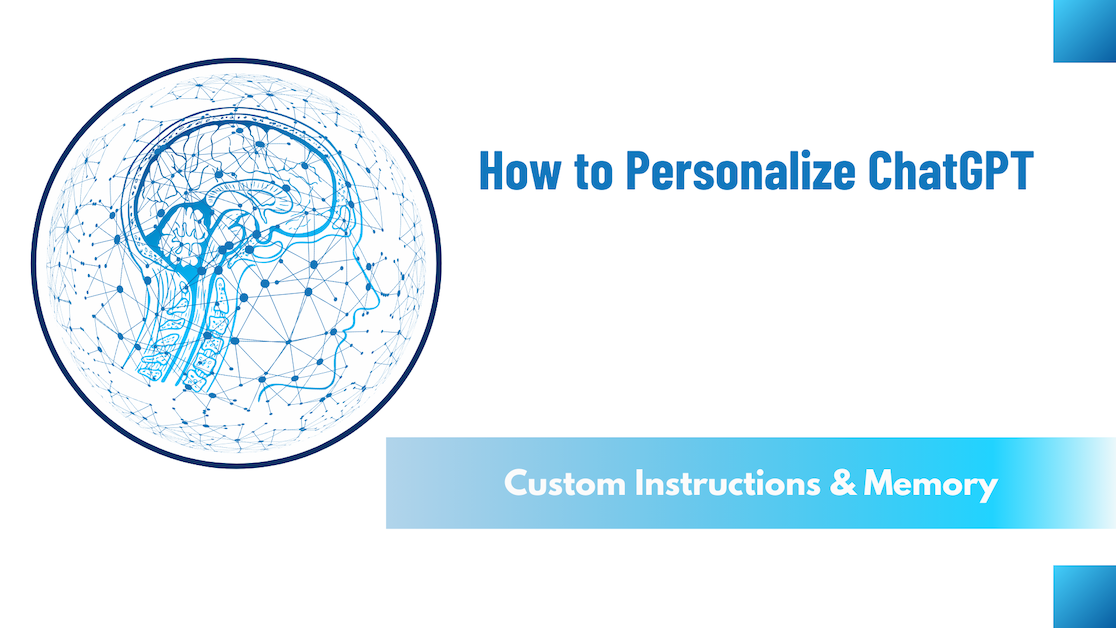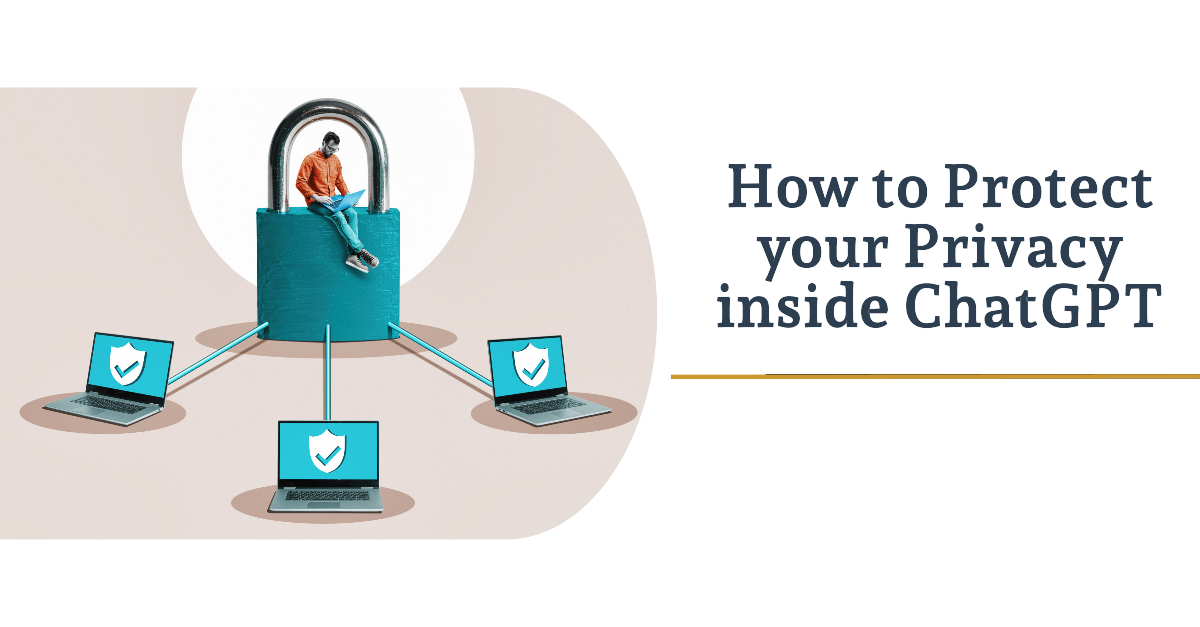Customize ChatGPT for Education: This article explores how to personalize ChatGPT for your individual usage. Personalization involves adjusting ChatGPT’s responses to align with your specific goals. For students, this could mean adjusting ChatGPT’s responses to meet learning objectives, preferred communication styles, and relevant background information. For lecturers, it may involve specifying teaching methods, course topics, and the level of detail appropriate for their students. We will examine the functionalities of custom instructions and memory. By the end, you’ll know how to use these tools in ChatGPT and you are good to go for creating your personalized ChatGPT.
Using ChatGPT’s memory functionality allows the AI to remember details from previous conversations. With a one-time setup, you won’t need to repeat information. You have control over ChatGPT’s memory; you can instruct it to remember specific details, ask what it remembers, or tell it to forget information, either conversationally or through settings. You can also turn memory off entirely.
How ChatGPT’s Memory Works
As you interact with ChatGPT, you can either explicitly ask it to remember specific details or allow it to automatically pick up on important information (the default setting). According to OpenAI, ChatGPT’s memory becomes more useful the more you use it, continuously adapting to your needs over time. You’ll notice these memory updates as your interactions progress.
ChatGPT’s memory functions similarly to custom instructions, which let you specify what you’d like it to consider when generating responses. However, unlike custom instructions that require manual updates, ChatGPT’s memory is designed to update automatically. When you share information that might be useful for future conversations, ChatGPT creates a summary of that information and adds it to its memory. This memory becomes part of the conversation record, influencing future responses.
You can teach ChatGPT to remember something new by simply chatting with it. For instance:
“Remember to simplify complex concepts by breaking them down into smaller, easier-to-understand parts.”
Manage ChatGPT’s Memory
If you’ve been using ChatGPT for a while, you may have noticed the message: “Memory updates.” This message appears whenever ChatGPT updates its memory based on your conversations. This feature keeps you informed of what’s being remembered, so you’re always aware of any changes. Given this, ChatGPT might already have stored several memory updates from your past chats.
Let’s take a look at what ChatGPT has stored so far and make a fresh start!
Hover over to Settings > Personalization > Memory. Like we did in the video below. Here you will find two options for deleting your memory:
- You can clear an individual memory by clicking on the
trash canicon next to the memory, and selectingClearin the pop-up modal. - All memories can be cleared at once by clicking on the
ClearChatGPT’s memory button on the bottom-right, and confirming by selectingClear memoryin the pop-up.
As you can see in the video, it has stored two previous memories from conversations we had previously with ChatGPT, we could delete them manually or in one go.
Turning Memory off does not clear your memories, and deleting a chat doesn’t erase memories remembered from that chat. You can tell ChatGPT to forget memories conversationally or by clicking Manage.
ChatGPT’s Memory and Privacy
Does memory remember sensitive information?
OpenAI states: "We’re taking steps to assess and mitigate biases, and steer ChatGPT away from proactively remembering sensitive information, like your health details - unless you explicitly ask it to. We are continuing to improve the model’s performance in this regard. You can always review and clear specific memories, as well as provide feedback so we can improve the model’s behavior in this regard."
- OpenAI’s acknowledgment of ongoing bias mitigation efforts highlights that biases still exist in the model and that ChatGPT could save sensitive information in its memory,
- Therefore, this poses privacy-related concerns when using for your studies.
- OpenAI’s statement that it is “continuing to improve the model’s performance” suggests that the current safeguards may not yet be fully reliable.
How long are ChatGPT’s memories retained?
Openai states: The “notepad” of your memories is kept separately from your chat history. This means that even if a chat is over or has been deleted, the memories created during that conversation can still be used in future interactions.
You can have the model forget memories at any time as explained above. If you ask the model to forget a memory, that memory will be removed from the “notepad” and will not be used when responding to conversations moving forward. We may retain a log of forgotten memories for up to 30 days for safety and debugging purposes.
Past conversations may include memories that existed at the time of the conversation. For example, if ChatGPT remembers that you live in San Francisco, ChatGPT’s response to “what should I do this weekend” may begin with “Since you live in San Francisco…” You can instruct ChatGPT to forget that memory at any time, though that does not clear memories that are part of your chat history. You can clear your previous chats to remove memories that are part of those conversations.
- Forgetting Memories: You can have the model forget memories at any time as explained above.
- Retention Period: OpenAI may retain a log of forgotten memories for up to 30 days for safety and debugging purposes.
- Past Conversations: These may include memories that existed at the time of the conversation. Clearing previous chats removes memories that are part of those conversations.
Some Considerations
When using ChatGPT’s memory feature, keep the following in mind:
- Privacy and Data Security: Be cautious about sharing personal or sensitive information. The safeguards are still under development and may not be entirely dependable.
- Bias: Understand that biases may still exist. Always critically evaluate the information provided.
- Control Over Memories: You have control over what ChatGPT remembers. However, some logs may be retained temporarily, and clearing memory doesn’t automatically remove all chat history.
When using ChatGPT, it’s important to understand how your data is handled and what steps you can take to protect your privacy. For more detailed guidance on protecting your privacy, including step-by-step instructions on managing your data settings, check out our article: How Can I Protect My Privacy Inside ChatGPT?.
In this video, we show how to tell ChatGPT to remember that we’re studying for a data mining exam and update it with what we’ve talked about. This way, when we start a new chat, we can easily pick up where we left off.
Memory & Custom Instructions
As we transition from discussing the memory functionality to exploring custom instructions, it is important to have clear idea on how these fucntion differ from each other and how these features work together add personalizing your ChatGPT.
- Memory allows ChatGPT to retain information from past interactions, learning and adapting over time to better suit your needs.
- Custom instructions, on the other hand, means you can specify specific guidelines for how ChatGPT should respond and what it should know for it’s response, adustig its behavior to a static set of preferences.
Set Up Custom Instructions in ChatGPT
Custom instructions creates a personalized learning experience by aligning responses with your background and preferences. Now that we understand how ChatGPT’s memory works and how to manage it, let’s begin setting up a personalized ChatGPT experience.
Customizing the behavior of ChatGPT varies per user and depends on how you want to use it. Just as it depends on your point of view, we will discuss in this section the use cases for both a teacher and a student. Note: the options below are stylized examples that demonstrate the possibilities to familiarize you with what is possible; you can use them. But we encourage you to start experimenting with the prompts yourself!
Step 1: Determine What ChatGPT Should Know About You
When setting custom instructions in ChatGPT, it is important to think about what information ChatGPT should know about you to adjust the answers. This field is your opportunity to inform the model about your current learning goals, your level of expertise, the specific technologies or topics you’re interested in, and any preferred learning styles. The goal is to make your interactions as relevant and customized as possible.
- If You Are a Student: Think about what you are studying, which courses you are taking, your level of study, your academic background, and for those using ChatGPT for data analysis, which programming languages you prefer the answers to be in, such as R, Python, or HTML.
- If You’re a Lecturer: Outline your role and the specific courses or topics you teach, the academic level of your students, the prerequisites you expect them to have, and the aim of your course. Additionally, clarify the depth of understanding you expect from your students.
Step 2: How would you like ChatGPT to respond?
Consider how you want ChatGPT to respond to your prompts as this section allows you to specify how you want the information presented. The key is to be specific about the type of response that will best suit your learning style and objectives. Consider factors such as depth of detail, format (e.g., code snippets, diagrams), and emphasis (e.g., practical examples versus theoretical discussions). Do you prefer concise summaries or in-depth explanations? Would you like practical examples, detailed case studies, or a focus on theoretical frameworks and formulas?
- If you are a student: Specify whether you want answers in a particular format, such as step-by-step solutions for mathematical problems, annotated code snippets for programming questions, or simplified explanations for complex concepts. Define the style, tone, and level of detail that suits your needs best, such as academic, conversational, formal, or accessible for beginners.
- If you are a lecturer: Indicate whether you would like ChatGPT to provide teaching resources, create quiz questions, develop lesson plans, or suggest activities to improve classroom engagement. Define the style, tone, and level of detail that suits your needs best, such as academic, conversational, formal, or accessible for beginners.
Example Cases
Lecturer’s Setup
1. What would you like ChatGPT to know about you to provide better responses?
I am a [subject/discipline] lecturer at a university in [country]. I teach [specific courses or topics, e.g., Machine Learning (ML) and Deep Learning (DL)] to students at the [Bachelor’s/Master’s/PhD] level. My students typically have a basic understanding of [basic concepts or terms, e.g., ML techniques], and they attend my course to explore advanced topics and practical applications in [advanced or specific technical concepts, e.g., data science]. I aim to provide content that is both technically rigorous and accessible to a diverse student body.
2. How would you like ChatGPT to respond?
Respond in a professional and concise manner, providing detailed explanations that include practical examples and real-world applications. Avoid filler words and focus on clarity. Begin with a brief summary that captures the main points in 3-5 sentences. At the end of your response, recommend additional topics or readings that students should explore for further understanding of the subject.
Notice how the response format has an abstract at the beginning and further reading at the end of the lesson. Without the use of custom instructions, you will have to make this information part of the prompt every time.
Student’s Setup
1. What would you like ChatGPT to know about you to provide better responses?
I am a student at a top-tier university currently studying [subject] at the [Bachelor’s, Master’s, PhD] level. I am an engaged and curious learner, passionate about understanding complex concepts at a deep level and synthesizing diverse ideas from various disciplines. I am eager to see how theoretical knowledge can be applied to real-world scenarios and to explore innovative approaches within my field. I appreciate responses that challenge my thinking, introduce new perspectives, and align with the rigorous academic standards of my institution.
2. How would you like ChatGPT to respond?
Provide responses that are intellectually stimulating and go beyond basic definitions to uncover underlying principles, theories. Use clear and precise language that remains accessible to non-native English speakers, but do not avoid challenging concepts or advanced ideas that promote deeper learning. Maintain a professional and academic tone, diving deeply into topics while minimizing filler words. Begin each response with a concise abstract of 3-4 sentences summarizing the main points. Conclude by suggesting related topics or areas for further exploration to help expand my understanding and encourage critical thinking.
Check out this example case.
Add More Instructions
Of course, you could vary the instructions and append them in numerous ways. Here is an example to think about:
Vocabulary Filter
You could use ChatGPT custom instructions to insert a vocabulary filter, start by defining a list of prohibited words and phrases that should be avoided during interactions. These could include specific terms, adjectives, nouns, verbs, and common industry phrases that may not align with the tone or style desired for a particular context or audience or just to simply filter out the ChatGPTish words. The vocability filter implemented as a memory constraint instructs ChatGPT to bypass these terms and instead use alternative language.
“I want you to avoid using the following words and phrases in all responses:
General words: ‘ensure,’ ‘enhance,’ ‘efficiently,’ ‘dive,’ ‘seamlessly’
Adjectives: ‘adept,’ ‘efficient,’ ‘ever-evolving,’ ‘exciting,’ ‘exemplary,’ ‘innovative,’ ‘invaluable,’ ‘robust,’ ‘seamless’
Nouns: ‘efficiency,’ ‘landscape,’ ‘realm’
Verbs: ‘aligns,’ ‘delve,’ ’embark,’ ‘underscores,’ ‘utilize’
Data analysis phrases: ‘deliver actionable insights through in-depth data analysis,’ ‘drive insightful data-driven decisions,’ ‘leveraging data-driven insights,’ ‘leveraging complex datasets to extract meaningful insights’
Conclusion
Personalizing ChatGPT offers both students and lecturers a way to customize ChatGPT and thereby improve their learning experience. By using features such as memory and customized instructions, you can adjusts ChatGPT responses to be in line with your learning objectives, communication styles, and relevant subject content. Although ChatGPT’s memory can help you maintain continuity and context in conversations, it is important to be mindful of privacy and data security. Additionally, customized instructions offer the possibility to direct ChatGPT’s responses precisely so that they align with your needs.
Experiment with these options to discover what ChatGPT has to offer!




